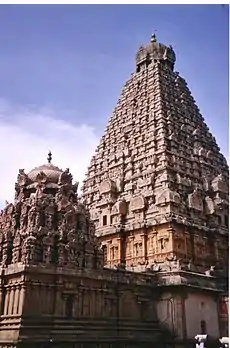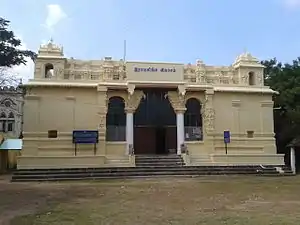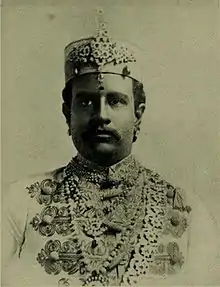Ramnad estate
The Ramnad estate was a permanently settled zamindari estate that existed in the Ramnad subdivision of the Madurai district and later Ramnad district of the erstwhile Madras Presidency in British India from 1601 to 1949. It was ruled by the rajas of Maravar caste who also had the title of Sethupathi. Maravars ruled the Ramnad area as traditional chieftains between 14th to 16th century CE, and in 17th century CE they expanded their power to establish "Ramnad Kingdom" which is also known as "Maravar Kingdom", in 1795 CE after the Carnatic wars they were reduced to the status of zamidari by the British raj. After the independence of India in 1947 the estates were merged in the Union of India and in 1949 all rulers lost the ruling rights, privy purse was also finally abolished in 1971.
Kingdom of Ramnad | |
|---|---|
| 1601–1949 | |
| Status | Kingdom, later Zamindari estate |
| Common languages | Tamil, English |
| Religion | Hindu |
| History | |
• Established | 1601 |
• Disestablished | 1949 |
| Part of a series on |
| History of Tamil Nadu |
|---|
 |
| Outline of South Asian history |
|---|
_without_national_boundaries.svg.png.webp) |
The seat of administration was the town of Ramanathapuram. The Zamindari had its origins in the Kingdom of Ramnad established by Raghunatha Kilavan in the late 17th century. In 1803, the Kingdom was converted to a Zamindari by the British. The male rulers of Ramnathapuram also bore the title of Sethupathi or "protector of the bridge", the bridge here referring to the legendary (Adam's Bridge) Rama's Bridge[1][2][3] while female rulers bore the title "Nachiyar".


History
The estate of Ramnad included the Hindu holy island city of Rameswaram, from where, legend has it that the Hindu god Rama launched his invasion of Ravana's Lanka. On the conclusion of the war and Rama's success in it, he appointed a Sethupathi or "lord of the bridge" to guard the way to the island. The "bridge" referred to here is the legendary Adam's Bridge or Rama's Bridge which was believed to have been constructed by Rama. The chieftains of Ramnad were entrusted with the responsibility of protecting the bridge, hence the appellation.
14th-16th century CE: As traditional Maravar chieftains
During the 14th and 15th centuries, the traditional chieftain Raghunatha Kilavan of the region who belonged to the Maravar caste was officially recognised as Sethupathi by the Nayak king of Madurai. The chieftain of Ramnad, in return, recognised the sovereignty of the Nayak king over his lands. When the power of the Nayak kings of Madurai began to decline in the late 17th century, the chieftains of Ramnad asserted their independence.
17th-19th century CE: Rise as Ramnad Kingdom or Maravar Kingdom
In the late 17th century, Raghunatha Kilavan crowned himself king of Ramnad and changed his seat from Pogalur to Ramnad close to the east coast. He ruled from 1673 to 1708 and oversaw the growth of the feudal chieftainship of Ramnad into powerful "Kingdom of Ramnad" which is known as "Maravar Kingdom". He erected massive fortifications to protect his capital. In 1725, the king of Tanjore claimed the northern part of the Ramnad kingdom (the Aranthangi region) up to the river Pambar in return for his services during the civil war in Ramnad. A vassal of Ramnad who was amongst the victors in the civil war took over the westerly located Sivaganga region, thereby leaving only three-fifths of the kingdom actually in the hands of the king of Ramnad.
19th-20th century CE: reduced to zamidari jagir during British Raj
Ramnad participated in the Carnatic wars between the British and the French East India companies. The state came under British influence in the 1790s and the king of Ramnad was deposed in 1795 for misrule. The British, then, made the king's sister the ruler of Ramnad and deprecated the kingdom to a zamindari by a permanent sanad granting them jagir of Ramnad in 1803. Since then, until the India's independence in 1947, Ramnad was ruled by the queen and her descendants.
Raja Bhaskara Sethupathi, who lived in the late 19th century, borrowed large amounts of money from Nagarathar creditors for construction of irrigation works and massive developments projects and for charitable purposes that he soon ran into heavy debt. In 1895, most of the estate was pledged to the creditors who set up a trust for its administration and maintenance. Bhaskara Sethupathi's successors actively supported the Justice Party. Shanmugha Rajeswara Sethupathi was an active supporter of the Justice Party and promoted the Self-Respect Movement.
After the independence of India in 1947, the Government of India marged estates, jagiirs, kingdom with the Union of India. COnsequently, in 1949 all rulers lost the ruling rights. In 1971, privy purse, an allowance given to the former rulers, was also ablloished , thus ending all entitlements.
List of Sethupathi rulers
Chieftains With the Madurai Nayaks
- Udaiyan Sethupathi (a) Sadaikkan (1601–1623)
- Koottan Sethupathi (1623–1635)
- Dalavai Raghunatha Sethupathi (1635–1645)
- Thirumalai Raghunatha Sethupathi (1646–1676)
- Raja Suriya Sethupathi (1676)
- Aathana Raghunatha Sethupathi (1677)
Independent kings of Ramnad Kingdowm
- Raghunatha Kilavan Sethupathi (1678–1710)
- Muthu Vairavanatha Sethupathi I (1710–1712)
- Muthu Vijaya Raghunatha Sethupathi (1713-1725)
- Sundaresvara Raghunatha Sethupathi (1725)
- Bavani Sangara Sethupathi (1725–1727)
- Kumara Muthu Vijaya Raghunatha Sethupathi (1728–1735)
- Sivakumara Muthu Vijaya Raghunatha Sethupathi (1735-1747)
- Rakka Thevar Sethupathi (1748)
- Sella Muthu Vijaya Raghunatha Sethupathi (1749–1762)
- Muthuramalinga Vijaya Ragunatha Sethupathi I (1762-1772 1781-1795)
Ruler of princely state under British Raj
- As king
- Mangaleswari Nachiyar (1795–1803)
- As Zamindars
- Mangaleswari Nachiyar (1803–1807)
- Annaswami Sethupathi (1807–1820)
- Ramaswami Sethupathi (1820–1830)
- Muthu Chella Thevar Sethupathi (1830–1846)
- Parvatha Vardhani Ammal Nachchiyar (1846–1862)
- Muthuramalinga Sethupathi II (1862–1873)
- Court of Wards (1873–1889)
- Bhaskara Sethupathy (1889–1903)
- Dinakara Sethupathy
- Raja Rajeswara Sethupathi (1903–1929)
- Shanmugha Rajeswara Sethupathi (1929–1967)
- Ramanatha Sethupathi (1967–1979)
- Rajeswari Nachiyar (1979–present)
Ramnad estate during British raj
Location

The estate of Ramnad was located between 9 degrees 6' and 10 degrees 6' N latitude and 77 degrees 56' and 79 degrees 19' E longitudes. It comprised the southern and eastern portion of Madura district and included the whole Bay of Bengal coast of the district.
Area and population
The estate covered an area of 2,104 square miles (5,450 km2) and had a population of 723,886 in 1901. It was one of the largest and most populous zamindari estates in the Madras Presidency. The zamindar of Ramnad paid a tribute of ₹ 3.75 lakh for the year 1903-04 to the British government.
Subdivisions
Then part of the Madurai district, the estate was subdivided into five zamindari tehsils: Ramnad, Tiruvadanai, Paramakudi, Tiruchuli and Mudukulathur. The administration was based in the town of Ramanathapuram in Ramnad tehsil. Ramanathapuram, Kilakkarai, Paramakudi, Rameswaram, Mandapam and Pamban were some of the important towns in the estate.
See also
- Sethupathi, title of Raghunatha Kilavan and his descendants
- Marava, community to which Ramnad / Sethypathu kings belonged
- Thanjavur Nayak kingdom, once and ally and later adversary of Sethupathis
- Madurai Nayak dynasty, once and ally and later adversary of Sethupathis
- Marava War of Succession, war of succession after Vijaya Raghunatha Sethupathi
References
- "Sethupathi Tondaimans". The History of Tamil Nadu. Retrieved 10 January 2021.
- "Holder of History:The Ramnad Sethupathis". High Beam. Archived from the original on 23 October 2012. Retrieved 10 January 2021.
- "Sethupathi Dynasty of Ramnad - Guardians of Rama Sethu". Bridge of Ram. Archived from the original on 6 October 2011. Retrieved 10 January 2021.
Bibliography
- The Imperial Gazetteer of India. Clarendon Press. 1908. pp. 177–179.